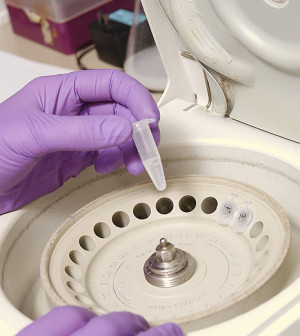- Navigating Your Midlife Crisis: Embracing New Possibilities
- City Raccoons Showing Signs of Domestication
- Mapping the Exposome: Science Broadens Focus to Environmental Disease Triggers
- One Week Less on Social Media Linked to Better Mental Health
- Your Brain Changes in Stages as You Age, Study Finds
- Some Suicide Victims Show No Typical Warning Signs, Study Finds
- ByHeart Formula Faces Lawsuits After Babies Sickened With Botulism
- Switch to Vegan Diet Could Cut Your Greenhouse Gas Emissions in Half
- Regular Bedtime Does Wonders for Blood Pressure
- Dining Alone Could Mean Worse Nutrition for Seniors
FDA Advisers: Ban Use of Behavior-Modifying ‘Shock Devices’


A U.S. Food and Drug Administration advisory panel has recommended banning the use of “electrical stimulation devices” to modify aggressive or self-harming behavior in people with severe emotional problems or developmental disorders such as autism.
“The FDA has grown concerned that serious risks of using these devices may outweigh the benefits for patients with limited intellectual ability or developmental disabilities, and that they may pose an unreasonable and substantial risk of illness or injury to patients,” agency spokeswoman Jennifer Rodriguez said prior to the panel’s vote Thursday evening.
The FDA isn’t required to carry out the recommendations of its advisory panels, but it usually does so.
The zapping devices are used as an “aversion therapy” technique at a center in Massachusetts that serves children and adults with serious special needs.
The FDA said that, as far as the agency is aware, the Judge Rotenberg Educational Center in Canton, Mass., is the only facility using the devices in an attempt to change behavior, according to background material released prior to Thursday’s vote.
Former Rotenberg students told FDA investigators they were burned by the devices, and felt anxiety, fear and depression.
It feels “like a thousand bees stinging you in the same place for a few seconds,” said one former student, adding the device “is torture, in the plainest sense of the word.”
Proponents of the shock technique say it discourages aggressive or self-injurious behavior. The students will stop punching themselves or others, for instance, to avoid being zapped, the thinking goes.
But the student told the FDA he received shocks “for things like noncompliance with staff direction, talking too much and being disruptive in class.”
The Rotenberg Center stands by its policy. The devices, usually applied to the arms or legs, deliver a two-second shock that “feels like a hard pinch but is otherwise harmless and has no side effects,” the center said in a statement.
“Without the treatment program at JRC, these children and adults would be condemned to lives of pain by self-inflicted mutilation, psychotropic drugs, isolation, restraint and institutionalization — or even death,” the statement from the center said.
The goal is to manage behaviors so these patients “can learn, and spend time with their family and friends,” the statement said.
The center makes its own devices on-site and does not offer them for sale. The devices are used only with prior parental consent or authorization from a Massachusetts probate court, the statement said.
Disability advocates have urged the FDA to ban these controversial tools. The United Nations has said use of electro-shock devices by the Rotenberg Center constitutes a violation of the UN Convention Against Torture, according to the FDA.
“It’s like putting a shock collar on a dog,” said Margaret Nygren, executive director of the American Association on Intellectual and Developmental Disabilities. “It’s designed for them not to be able to remove it. It’s just degrading.”
These types of devices have been around for decades, and there currently are four FDA-approved models. Two similar devices are approved for use in smoking cessation and stopping nail biting, but those are not being considered for the ban.
The instruments in use at the Rotenberg Center lack FDA approval because they have been substantially modified from earlier models. One device “has an average output current that is almost three times that” of the FDA-approved model, the agency said.
Studies have shown that negative reinforcement does not provide a long-term solution to behavior problems in developmentally disabled people, Nygren said.
“In the long run, as the punishment is removed, the behaviors return,” she said.
A better strategy involves figuring out why the behavior occurs and then making changes that head off the behavior, Nygren said.
For example, a student might be hurting himself because he is hungry but can’t think of how to communicate that need. Once instructors figure this out, they can come up with other ways for the person to communicate — for example, by providing a card he can hold up when he is hungry.
But dozens of parents with children at the Judge Rotenberg Center argue otherwise in letters of support for the devices submitted to the FDA.
“Our kids are one punch away from going blind or killing themselves and need treatments that work quickly with minimal side effects,” wrote the parents of a daughter with a rare form of epilepsy. “It would be a terrible injustice to deprive a child of such an effective life-saving treatment when all other available treatments have consistently failed.”
More information
To read the government report on a potential ban of electrical stimulation devices, visit the FDA.
Source: HealthDay
Copyright © 2025 HealthDay. All rights reserved.










